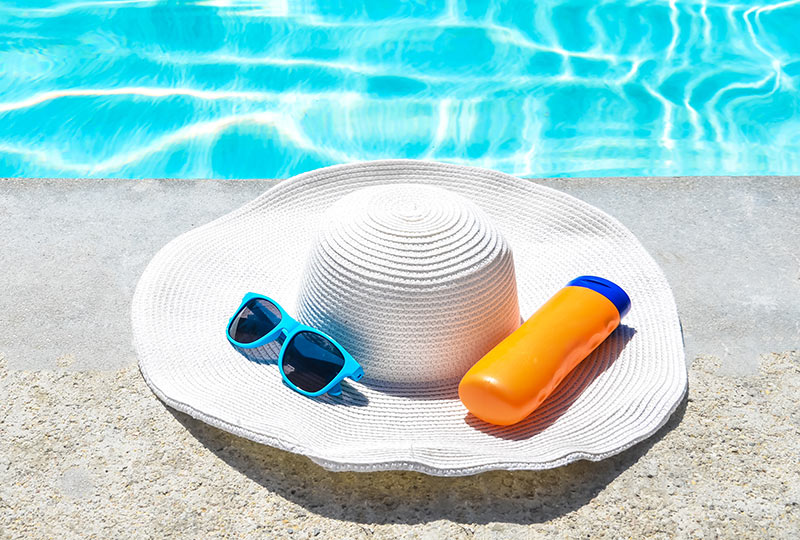On a bright, sunny day, you decide to go swimming at your local pool or beach. You’ve heard more than a few times that it’s important to apply sunscreen in this kind of situation. However, you don’t have any available at the moment. Or maybe you have some, but don’t like the way it feels when you put it on. So you decide to skip this recommended step and go swimming with your skin unprotected.
Unfortunately, thousands of people make this same mistake every time the warm weather arrives. As it turns out, there are very good reasons for the universal public health warnings to wear sunscreen. When properly applied, this skin protectant can keep you from looking old before your time. Perhaps more importantly, sunscreen can help you ward off a future case of lethal or non-lethal skin cancer. Let’s take a closer look at why you should never skip sunscreen.
How Does Sunlight Damage Your Skin?
Before we explore the benefits of sunscreen, it helps to know what ordinary sunlight can do to your skin. All sunlight contains something called ultraviolet (UV) radiation. The invisible rays come in two separate forms, known as UVA and UVB.
When it strikes your skin, UVA radiation penetrates deep enough to affect pigment-producing cells called melanocytes. This is what causes your skin to tan. However, at the same time, UVA damages your skin. Specifically, it triggers signs of premature aging such as age spots and wrinkles.
UVB radiation doesn’t penetrate into your skin as far as UVA. Instead, these “burning” rays only affect your skin’s outer layer or epidermis. This is the form of radiation contact that causes sunburn.
UVA and UVB share one thing in common. Namely, they can damage your skin and increase your chances of developing a related form of cancer. UVA radiation is the weaker of the two, but can still alter the DNA of individual cells. It can also suppress the normal function of your immune system. Stronger UVB radiation is linked to even more forms of cancer than UVA. Together, the two forms of radiation account for between 95% and 99% of all skin cancer cases; another reason you should never skip sunscreen.
What Does Sunscreen Do?
Sunscreen protects your skin by creating a barrier against the effects of UV radiation. It comes in a wide variety of forms, including creams, ointments, lotions, sprays, gels, lipsticks, and lip balms. Some available products are chemical sunscreens, and function like sponges by soaking up UV rays. Others are physical sunscreens and deflect radiation away from your skin.
What Type of Sunscreen Should You Use?
The American Academy of Dermatology (AAD) provides comprehensive guidelines on the best uses of sunscreen. To begin with, the AAD recommends that you use only broad-spectrum products. These products get their name because they provide protection against both UVA and UVB radiation.
Current guidelines also recommend that you use a sunscreen that’s SPF 30 or higher. SPF is short for sun protection factor. It measures how well a product protects you from UVB radiation. Crucially for swimmers, the AAD also recommends that you use only water-resistant sunscreens.
When it comes to the form of sunscreen you apply, the American Academy of Dermatology has just one key recommendation. Whether it’s a cream, spray or something else, find something that you like and will use regularly. After all, sunscreen can’t do its job if you never put it on your skin, which is why you should never skip it.
How Much Should You Use, and How Often?
It takes about one ounce of sunscreen to fully protect the body of an adult swimmer. Unfortunately, most people only apply about ¼ to ½ that amount before hitting the water. The AAD recommends that you cover your dry skin a good 15 minutes prior to any sunlight exposure.
Make sure to cover all possible exposed areas, including your ears, neck and the tops of your feet. If you have a bare scalp, also apply sunscreen to the top of your head. And don’t forget to apply a protective lipstick or balm to your lips, as well.
As a general rule, anyone outdoors should reapply their sunscreen at two-hour intervals. However, swimmers should refresh their skin protection whenever they exit the water. The same holds true for anyone who stays out of the water but sweats a lot.
Need more advice on how to protect your skin while swimming? Just ask your local swim teachers at Blue Buoy. We’ll have plenty of tips on how to have plenty of fun in the water, all while keeping your skin safe and healthy.



Leave A Comment